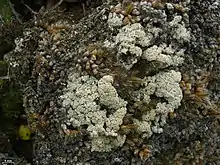| Ochrolechia upsaliensis | |
|---|---|
 | |
| Scientific classification | |
| Domain: | Eukaryota |
| Kingdom: | Fungi |
| Division: | Ascomycota |
| Class: | Lecanoromycetes |
| Order: | Pertusariales |
| Family: | Ochrolechiaceae |
| Genus: | Ochrolechia |
| Species: | O. upsaliensis |
| Binomial name | |
| Ochrolechia upsaliensis (L.) A.Massal. (1852) | |
| Synonyms[1] | |
|
List
| |
Ochrolechia upsaliensis is a species of crustose lichen in the family Ochrolechiaceae. Found in the Northern Hemisphere, it is commonly known as the tundra saucer lichen.[2]
Taxonomy
The lichen was formally described as a new species by Carl Linnaeus in his 1753 work Species Plantarum. He placed it in the eponymous genus Lichen, as he did with all of the 80-odd lichens he described in this work.[3] Abramo Bartolommeo Massalongo transferred the taxon to the genus Ochrolechia in 1852.[4]
Description
The thallus of Ochrolechia upsaliensis is white to grayish-white, and crustose; the thallus thickens with age. The texture of the thallus surface ranges from smooth to granular. The lichen produces abundant apothecia; these reproductive structures are shallowly saucer-shaped, measuring 0.5–3 mm in diameter, with a pale-buff disc. The ascospores typically number 8 per ascus; they are ellipsoid with dimensions of 31–69 by 23–37 μm.[5]
Ochrolechia upsaliensis reacts negatively to all standard lichen spot tests.[5]
Habitat and distribution
Ochrolechia upsaliensis has a Northern Hemisphere distribution, having been reported from Europe, arctic areas of Alaska and Canada, Greenland, and mountainous areas of the United States. It also occurs in mountainous areas of Europe.[5] There, it prefers habitats with calciferous soil and plant debris, and grows optimally above the treeline. In the Alps, where it is widespread, Ochrolechia upsaliensis reaches the Nival zone.[6] It typically overgrows mosses, sedges, grasses, or grows on the ground; less frequently, it has been recorded growing on rock.[5] In Greenland, it is a component of the lichen-rich biological soil crust.[7]
References
- ↑ "Synonymy. Current Name: Ochrolechia upsaliensis (L.) A. Massal., Ric. auton. lich. crost. (Verona): 31 (1852)". Species Fungorum. Retrieved 26 August 2022.
- ↑ Brodo, Irwin M.; Sharnoff, Sylvia Duran; Sharnoff, Stephen (2001). Lichens of North America. Yale University Press. p. 468. ISBN 978-0300082494.
- ↑ Linnaeus, Carl (1753). Species Plantarum (in Latin). Vol. 2. Stockholm: Impensis Laurentii Salvii. p. 1142. doi:10.5962/bhl.title.37656.
- ↑ Massalongo, Abramo Bartolomeo (1852). Ricerche sull'autonomia dei licheni crostosi (in Latin). Verona: Dalla tipografia di A. Frizierio. p. 31.
- 1 2 3 4 Howard, Grace E. (1970). "The lichen genus Ochrolechia in North America North of Mexico". The Bryologist. 73 (1): 127. doi:10.2307/3241590.
- ↑ Nimis, Pier Luigi (2016). The Lichens of Italy. A Second Annotated Catalogue. Trieste: Edizioni Università di Trieste. p. 324. ISBN 978-88-8303-755-9.
- ↑ Hansen, E.S. (2001). "Lichen-Rich Soil Crusts of Arctic Greenland". Biological Soil Crusts: Structure, Function, and Management. Ecological Studies. Vol. 150. Berlin, Heidelberg: Springer Berlin Heidelberg. pp. 57–65. doi:10.1007/978-3-642-56475-8_4. ISBN 978-3-540-43757-4.